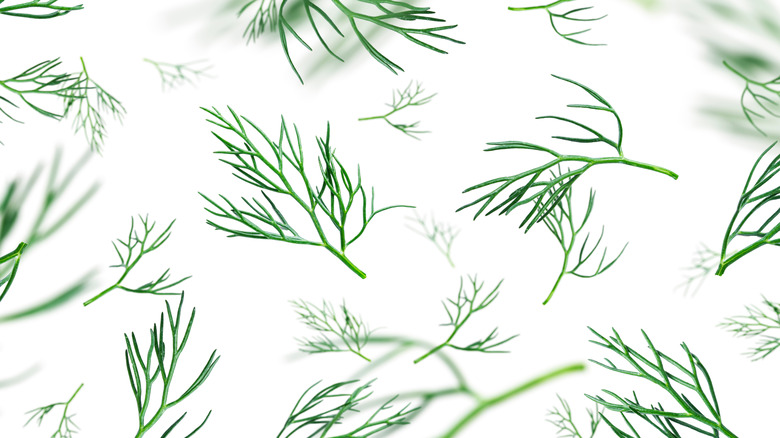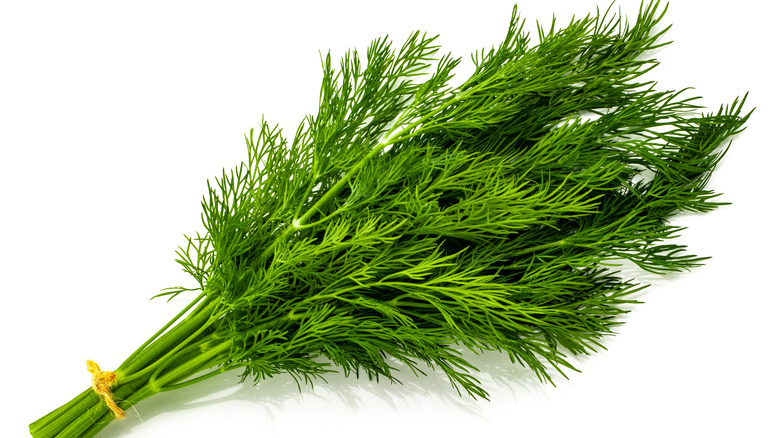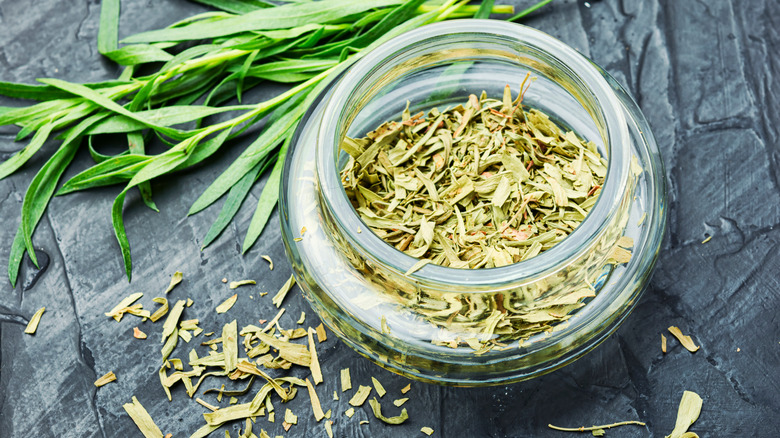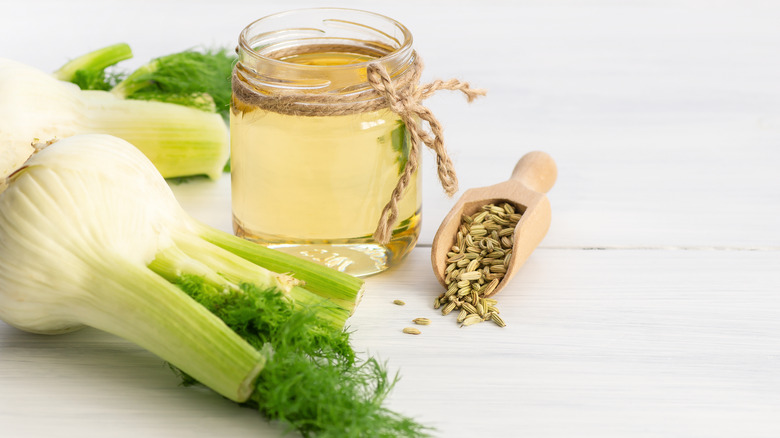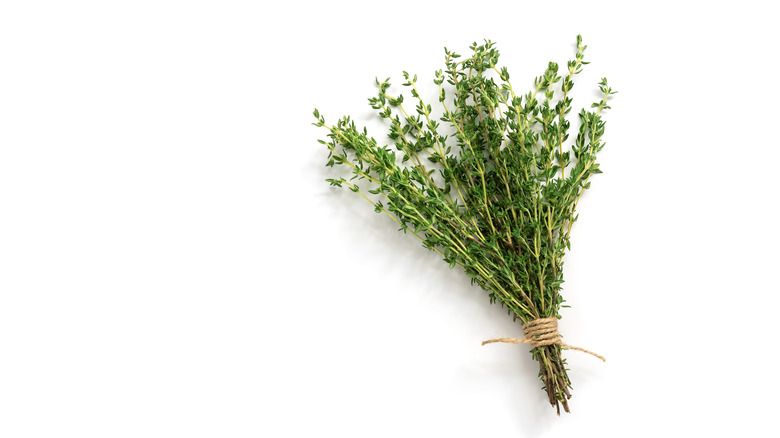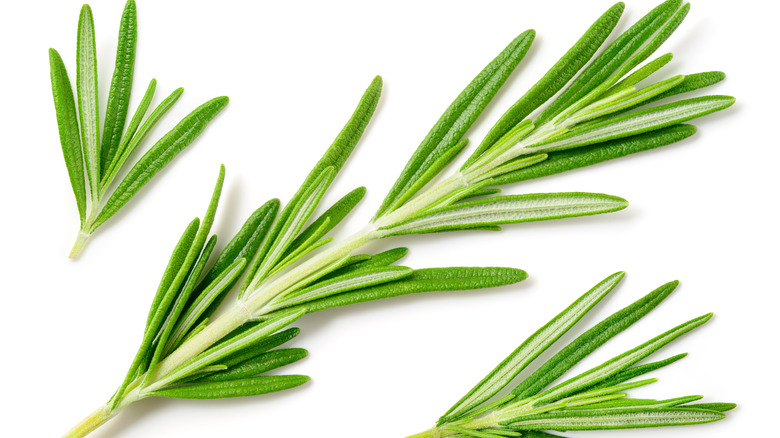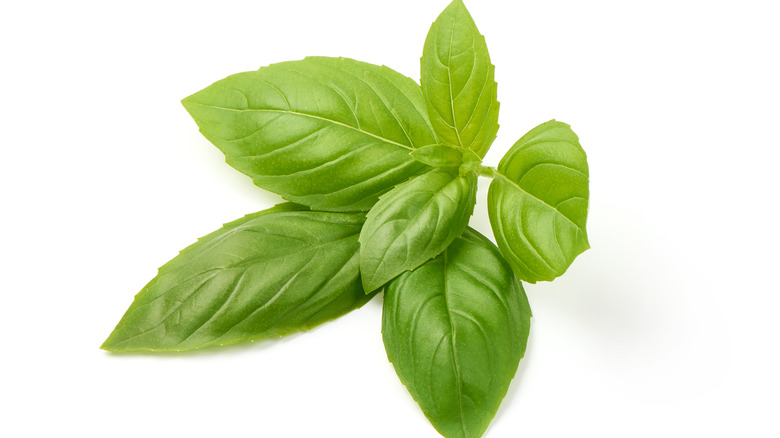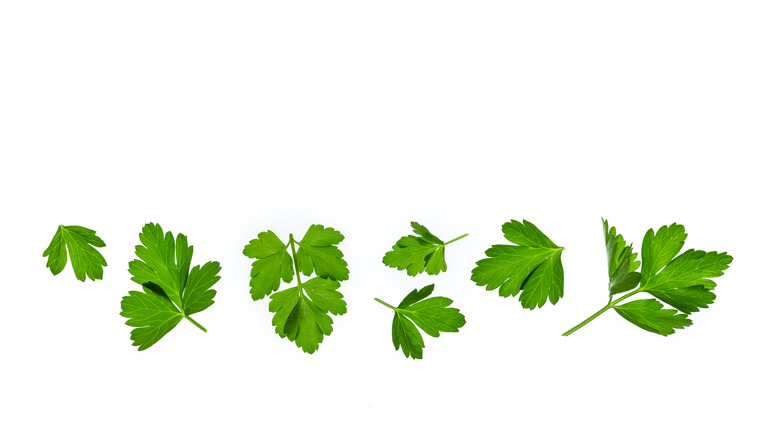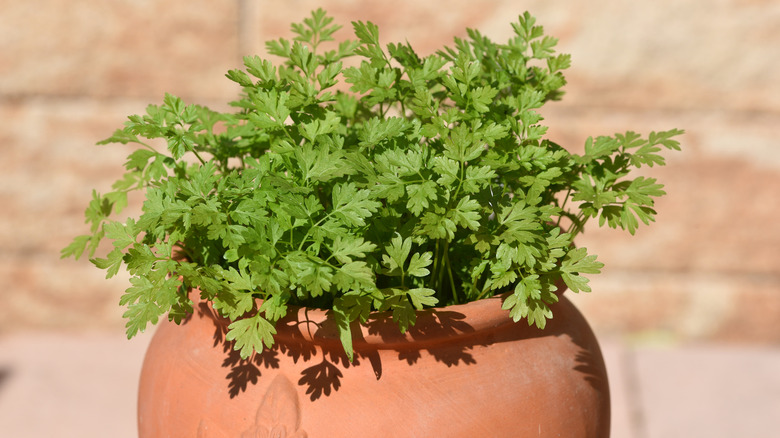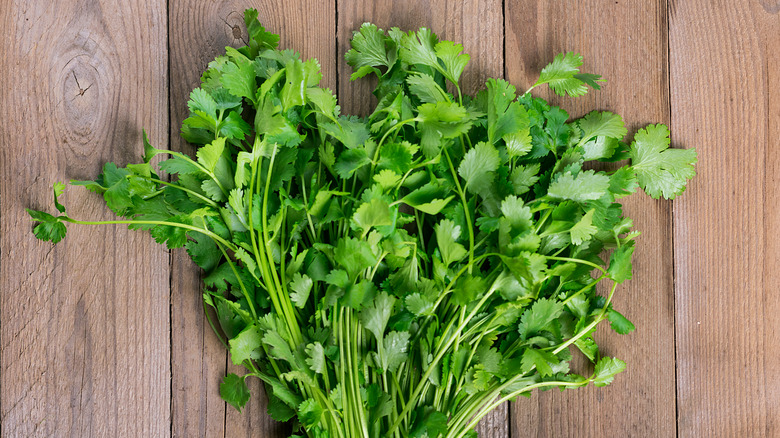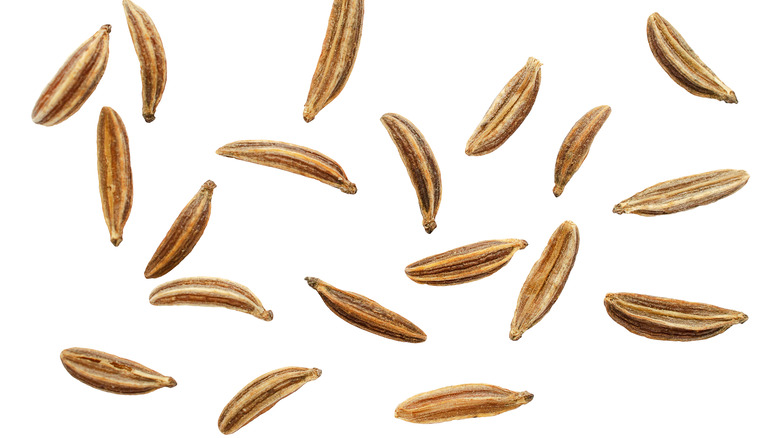9 Best Substitutes For Dill
We may receive a commission on purchases made from links.
Thanks to its name, the first thing that comes to mind when you think of dill is, of course, pickles. With the botanical name Anethum graveolens, dill belongs to the same family as parsley and celery, says Wildflowers & Weeds. Its wispy leaves are the herb dill weed, which tastes like a combination of licorice-y anise and grassiness, while the flat, oval fruit it bears is the spice dill seed, reminiscent of caraway in flavor.
While dill is native to the Mediterranean region and western Asia, it's easy to grow anywhere, according to Gardeners Path. Dill will grow up to three or four feet. The name "dill" comes from the Norse word "dylla," meaning to soothe, because dill's medicinal benefits were discovered early on — it's particularly good for upset stomachs. Throughout history, it's been medicine for the ancient Egyptians, a good luck symbol for ancient Romans, a sign of wealth for Greeks, and an appetite suppressant for kids during long church days (via The Herb Society of America).
Today, we know dill seed has breath-freshening and anti-bacterial properties, and we also know it's a delicious addition to many dishes. In addition to pickling, dill frequently shows up with seafood, and is prominent in borscht, ranch dressing, and tzatziki sauce. The options don't stop there: dill works for stews, meats, casseroles, pasta, eggs, salads, and dips. With dill being such a common ingredient, it's important to know what we can substitute for it when we're cooking and realize we're all out of it. What else achieves similar flavor and/or effect?
Swapping seed for weed and fresh for dried
Before we start discussing other ingredients you can call on for the dill effect, let's cover all the forms of dill. According to MasterClass, you can either use dill weed or dill seed. If you have fresh dill weed leaves on hand, make sure to add them when your dish is almost done cooking, because the longer the leaves are heated, the more flavor and color they lose. If you have dill seed, you can add them crushed or whole earlier on, as the heat will instead bring out the seeds' flavor as the cooking progresses (via Serious Eats).
The other difference in dill is fresh versus dried. You'll find dried dill in the spice aisle at your local grocery store. The little jar is super convenient to have in your kitchen, but it packs a lot less flavor and aroma than clusters of the fresh, leafy stuff you'd instead find in the produce section. So, you'll want to use more dried dill than you would fresh, but remember the weights are different since fresh dill is feathery leaves and dried dill is packed, chopped leaves.
One tablespoon of chopped fresh dill equals one teaspoon of dried dill, says HealWithFood.org.
1. Tarragon
Spiceography says the best thing to use for the effect of dill with no dill is tarragon. This is because tarragon also has an anise quality to its flavor and aroma.
Tarragon, or Artemisia dracunculus, is a member of the sunflower family, says The Kitchen Magpie. This herb is more popular in European cooking; in America, we often use chives, rosemary, or parsley where one might instead throw in tarragon. There are three kinds: French tarragon, Russian tarragon, and Mexican tarragon. French tarragon is the most common and what you're probably buying when you find it in the grocery store.
Like dill, tarragon packs quite the flavor punch and so should be added carefully so as not to overpower any dish. Unlike dill, however, tarragon can hold its own under the heat of cooking, Spiceography writes, so you can go ahead and add it earlier in the preparation of your recipe.
Another similarity to dill, according to Dr. Gourmet, is its fresh-versus-dried ratio. If you only have dried tarragon, think one teaspoon for every tablespoon of fresh leaves that a recipe calls for.
2. Fennel
Fennel, too, has a licorice-esque, anise quality to it, meaning that you're going to get at least close to your desired flavor effect even if you don't have dill. Like dill, fennel, or Foeniculum vulgare, has feathery fronds you'd use in the same way you would dill leaves.
Fennel belongs to the same family as carrots, parsnips, parsley, and coriander, according to Encyclopedia Britannica. Its bulb base is considered a vegetable, and is more often called for chopped and cooked in recipes. Those fronds, however, are its herb part, and still contain that delicate anise flavor. These tend to be used to make sauces and pestos.
The fronds and related flavor and aroma profile makes fennel a super easy swap for dill, allowing you to use the same proportions of its leaves as you would with dill weed. If you buy a jar of fennel seed from your supermarket's spice aisle, you'll get a more concentrated flavor in each teaspoon (via LEAFtv).
3. Thyme
With thyme, we move a step away from dill's licorice-tinged character, but we still have an herbal, grassy, ingredient that easily jazzes up the final flavor of meat, seafood, stews, salads, dressings, and sauces. Thyme, scientifically referred to as Thymus vulgaris, belongs to the mint family, though any similarity to mint really just comes through as a clean sensation rather than anything resembling what you'd add to a mojito. In addition to its herbal grassiness, thyme has woody, floral notes, and there's also a lemon thyme variety with a citrusy taste.
Like dill, thyme can be found fresh in the produce department and dried in the spice aisle. According to Thrive Cuisine, fresh thyme has a cleaner taste, so even more of that not-so-minty minty-ness, basically. Thyme differs from dill, however, in that heat will bring out its flavors. So, you can add it earlier in your cooking than you would with dill.
Recipe Marker notes that thyme can have a more "pungent" flavor, so for best results, use a smaller amount than you would dill to start and scale up from there as needed.
4. Rosemary
A member of the Lamiaceae family, rosemary is also related to mint. It's a durable-leaved herb with a complex flavor and aroma profile. With notes of evergreen, citrus, lavender, sage, and mint, one could describe rosemary as anything from piney to resinous to peppery to lemony to woodsy, and it can be a touch astringent.
What dill is to pickles, rosemary is to red-skinned potatoes. It's also a common partner to different meats, and it might be chopped into bread or biscuit dough. Rosemary also works wonders for beans and lentils. While rosemary doesn't have the same flavor and aroma profile as dill per se, as you can see from where it's often used, this ingredient has a similar herbal quality to it that elevates the kinds of dishes where you might also use dill.
Rosemary, too, can be fresh in the produce section or dried in the spice aisle. Uniquely, rosemary doesn't lose much of its flavor when dried because it has a low level of moisture to begin with (via Oven Via). When using fresh rosemary, it depends on the recipe: sometimes you add whole leaves, or crushed or chopped leaves; other times, you add the entire stem while the dish cooks and remove it before serving. The latter approach is common for soups and sauces.
If you're using rosemary in place of dill, chances are you'll want to go with whole or chopped leaves.
5. Basil
Tastessence recommends basil if you're left dill-less in a pinch. Known as Ocimum basilicum, basil is also part of the Lamiaceae family with rosemary.
The trick to substituting basil for dill is understanding the difference between basil's two forms, fresh and dried, says Spiceography. Fresh basil has more of that anise flavor that dill has. Since basil is easy to grow and is a popular choice for gardeners, it might be easy for you to go the fresh route — maybe it's in your own backyard, even — and this will give you a pretty close dill effect. If you instead find yourself reaching for dried dill in the spice aisle, know that you're getting the herb's minter, less anise-y side.
Basil is a popular ingredient in Italian and Asian cooking. You may have had it in Thai dishes, or on pizza. Fresh basil is just lovely with mozzarella and tomato. Thanks to its anise-y, herbal character, however, basil can just as easily understudy dill.
According to HealWithFood.org, you'll want to use about half the amount of dried basil as you would fresh.
6. Parsley
According to The Daring Kitchen, "dill is often compared to parsley in that they both offer the 'fresh' flavor of a green herb." While parsley has a much subtler flavor than dill, it will still bring that almost-grassy herbal quality to any dish, and it's incredibly versatile. Parsley is the star of the sauce chimichurri and an essential ingredient in the Mediterranean salad tabbouleh), proving its dill-like capabilities of anchoring a sauce or a dish.
Parsley is known as Petroselinum crispum and is a member of the Apiaceae family, writes MasterClass. It's often used to bolster other flavors in a dish, or as garnish thanks to its vibrant green leafiness. There are four types of parsley: flat leaf, curly leaf, Hamburg or "parsley root," and Japanese parsley, though MasterClass says flat leaf and curly are the most common. Flat leaf has a peppery finish to it and curly is milder.
Parsley can be fresh or dried, and you'd follow similar guidelines as you would with dill or similar herbs: add more fresh leaves than you would dried parsley, and fresh parsley should only be added at the end of cooking because too much heat will drain its flavor.
7. Chervil
Delicate, leafy, and subtly licorice-y, chervil makes a great dill substitute. It's got a milder quality to it than dill, but will have a similar effect on whatever recipe you use it in.
Known as Anthriscus Cerefolium, chervil might not be such an obvious choice because it's less known and used in American cooking, says MasterClass. It's an extremely popular staple in French cuisine, so if you're a Francophile in the kitchen, there's a chance you prioritize having your chervil over your dill. Chervil often gets confused with parsley based on its appearance, and like parsley, it's good for bringing out the other flavors in a dish.
Fresh chervil is lovely as a garnish and to bring in that nice herbal flavor, a la dill, toward the end of cooking. It's also tough to find. You might find it at specialty European grocery stores or farmers markets, but you'll probably have an easier time finding it dried in the spice aisle of a supermarket. Dried chervil should be added earlier in cooking so its flavors can develop (via MasterClass).
Cuisine Vault recommends using one tablespoon of chervil for every half tablespoon of fresh dill.
8. Cilantro
Dill weed and cilantro belong to the same family, according to Tastessence. While cilantro's flavor is more lemony and peppery — or soapy, depending on your genetic predisposition — its leafiness makes it similar to dill in preparation and handling, and it succeeds in giving dishes a bright, fresh, herbal quality.
Cilantro is an herb, and this refers to the leafy part of the coriander plant, Coriandrum sativum. That plant's seeds, coriander seeds, are a spice with a nuttier finish and a touch of heat. While cilantro is known for how well it goes with tacos, it's a versatile herb used to elevate meat, seafood, vegetables, sauces, and salsas.
Cilantro does come dried in the spice aisle, but its flavor is significantly muted in this form. Fresh cilantro is pretty easy to find in the produce section and at farmer's markets, and is definitely ideal for maximum flavor impact. Use a similar amount of cilantro as you would dill, but feel free to taste as you go to make sure it's not overpowering.
9. Caraway seeds
As mentioned above, dill can be found in both weed and seed forms. The seeds taste like the weed, but with more of a bitter edge. Caraway seeds, aka Carum carvi, are nutty and bittersweet with notes of citrus, pepper, and anise, according to MasterClass. In other words, they're a pretty close match for dill seeds and even dill weed if you need a quick understudy.
The only real variations in caraway seed comes down to whether you want to go the whole or ground route, which is just about how much texture and crunch you want in a dish. Caraway seeds are pretty strong in their flavor, so a little goes a long way, and their flavors and aromas will develop nicely as they're heated during the cooking process. Since they're easy to find in the spice aisle, caraway seeds are a versatile staple that definitely do the trick when you need dill.
